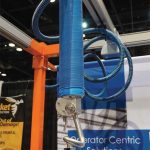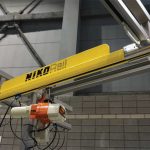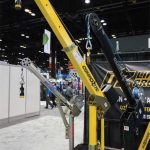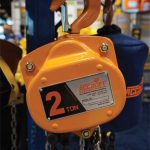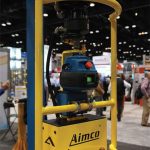Promat took place in Chicago in April, with crane and handling equipment manufacturers lining up alongside other members of the logistics industry. Daniel Searle attended.
Germany-based Demag celebrates its 200th anniversary this year. The company’s stand at Promat featured archive photographs of its past operations, whilst showcasing some of its present-day technology.
The system has no limit on railway length, and combines a steel column with an aluminium crossbar—a steel crossbar can be used, but this diminishes capacity. The aluminium rails, as well as being lightweight, also offer a rolling resistance so low that the beam has to be perfectly level to prevent unwanted movement.
A T-shape variant is also available, with, for example, a metre of rail on one side as a place to hang supply lines such as air or water.
Gorbel, a manufacturer of cranes and ergonomic lifting systems, introduced new technology utilising the ‘Internet of Things’, also known as Industry 4.0—essentially, the ability of equipment to measure and record real-time performance data and connect with other equipment, to improve efficiency and workflow.
The technology will be added to the company’s G-Force actuator as part of the Q2 and IQ2 models. Due for launch in the summer, it provides the operator with dashboard information and maintenance programmes, including a connection via Gorbel’s G-Link system to the company’s analytics database, which enables Gorbel to perform preventative maintenance and analysis remotely. And for those concerned about data security, the data can be stored in ‘the cloud’ or kept within the walls of the facility.
The company is also planning to launch an upgrade to its overall G-Force operation platform. Other recent innovations include Gorbel’s foundationless jib cranes, which have capacities of up to 1t and are fixed with epoxy bolts, thereby offering savings as minimal alterations to the facility floor are required compared to conventional cranes.
Business in the US is currently strong, said Rob Beightol, marketing director at Gorbel: “Overhead material handling companies seem to be having a very solid year. The economy is very solid and is continuing to yield dividends in the manufacturing space.”
Piab was promoting the first Industry 4.0-compatible vacuum lifting system on the market, the piLIFT SMART, which now comes with the company’s IO-Link.
The technology provides a real-time digital load read-out, which helps the operator to ensure safe lifts and is also used by the system to determine the amount of power required to maintain the vacuum for each lift. This is then controlled accordingly via the unit’s frequency-driven pump, cutting overall power consumption by 76% compared with other vacuum lifters, said Markus Olofsson Carlbom, product manager at Piab’s ergonomic handling division. Keeping the air flow at a minimum also enables the system to produce almost no sound.
The control system is also designed to be very responsive, says Carlbom, and to enable gentle lowering of loads to surfaces. As well as assisting performance, the lifting data accrued is also available via a webbased platform, enabling both operator and operation to obtain live information on status.
The technology enables information to be integrated into customer systems, and could in the future be equipped with RFID readers, for control and quality checking—such as ensuring that loads are carried to the correct place, and optimising stockholding.
Ergonomically, the system requires less physical support from the operator compared to some manipulators, as a two-button interface on the handle stepless controls vertical movement. piLIFT SMART is also equipped with an automatic pick and place feature, designed to assist with hard-to-reach loads, such as when picking or placing an object deep inside a pallet or a box.
Columbus McKinnon is aiming to change the hoist market so that all hoists use a variable frequency drive, said Paul Smielecki, marketing manager at the company: “The drives have been seen as an upgrade over traditional contactor control, and they improve safety and give better performance.”
At Promat, the company showcased its Lodestar VS electric chain hoist, which features a VFD and is compatible with Columbus McKinnon’s Hi-Tech interface, a user interface that enables the operator to programme the drive via a Windows laptop or tablet, as well as providing hoist status and maintenance information. The company is also looking at adding operational data to the Hi-Tech system’s capabilities, said Smielecki, and developing a wireless set-up so the interface can be accessed through a mobile device.
At Illinois-based Handling Systems International’s (HSI) stand, the company was promoting its newly-launched NikoRail enclosed track crane system.
The system, which is available in customised set-ups with capacities up to 2t and bridge lengths up to 10m, offers a low pulling force thanks to the guide rail rolling on the inside surface of the track. The standard system is made from steel for strength, said Bret Lussow, director of business development at HSI, although an aluminium option is available.
Mike Rehor, vice president of sales and marketing at HSI, said: “We’ve partnered with Helm Hellas from Greece to provide us with the rail and a full line of hardware and components to offer some unique material handling solutions. We are bringing in the raw, roll formed steel and welding the cranes right here in our new McCook, Illinois facility.
“We have seen strong demand for enclosed track cranes over the past several years and this product compliments our dealers desire to have an alternative source and Midwest manufacturer of enclosed track cranes. Our new facility will allow us to more easily manufacture this product and service our dealers’ needs.”
The company was also promoting its aluminium gantry cranes, and its foundationless jib crane, available with capacities of up to 1t, and a height and arm length of 16ft.
Minnesota-based OZ Lifting Products featured their range of innovative davit cranes, the CompOZite and CompOZite Elite series, which use advanced composite materials to combine heavy load capacities with an ultra-lightweight design.
“Manufactured in the USA the cranes are less than half the weight than the steel equivalents while providing the same strength,” said Richard Miller at OZ. “They are pound for pound the lightest and strongest in the market.”
The carbon fibre davit crane system weighs 37lb and provides a 1,200lb capacity, enabling the crane to be transported by one person, and requires no tools to assemble, which allows for one-person assembly. The model on display at Promat was one of the first production models.
The composite crane was launched in 2014 and has had success in a variety of industries around the world, said Miller. The material is particularly suited to sectors such as wastewater, property management, aviation and boat manufacturers among others. The cranes are non-corrosive and non-conductive, and all OZ davit cranes are individually tested and certified at 125%.
Also being promoted by OZ at the show were its range of manual chain hoists, in capacities from 1/4t–30t and lever hoists from 1/4t–9t. They also offer an electric chain hoist range and an electric builder’s hoist in 500lb and 1,000lb capacities offering 90ft of lift with up to 75ft/m of lift speed.
The company also produces brake winches, beam clamps, and a patented trolley that can be set to the correct beam width without the use of washers or bolts and features a glow-in-the-dark measuring label.
